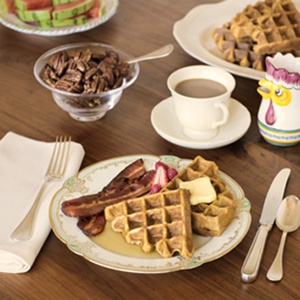It’s hard to resist a drink with a name like shrub!
 Before the invention of refrigeration, shrub syrups were made to preserve ripe fruits for later enjoyment. In Colonial America, shrubs were popular for mixed drinks, and recently they’ve been making a comeback!
Before the invention of refrigeration, shrub syrups were made to preserve ripe fruits for later enjoyment. In Colonial America, shrubs were popular for mixed drinks, and recently they’ve been making a comeback!
Shrub drinks are based on shrub syrups made from fruit, sugar, and vinegar. These syrups are also known as drinking vinegars, which is appropriate enough because the word shrub comes from sharab, an Arabic word meaning syrup and sharbat, a Hindi word for drinks based on syrups made from fruit extracts.
Served chilled and mixed with still or sparkling water or spirits, shrubs are a very refreshing way to balance tart and sweet. Almost any ripe berry and fruit can be used to make a shrub. Just follow the seasons and enjoy fruit-infused vinegar drinks that are based on citrus, strawberries, cherries, apricots, blackberries, raspberries and other delicious berries, peaches, tomatoes, watermelon, pears, figs, and so on!
Experiment by adding different vinegars, sugars, and herbs and spices such as lemon verbena, lavender, basil, tarragon, mint, rose geranium, cloves, cinnamon, and peppercorns.
On a hot afternoon a shrub makes a great thirst quencher, and before dinner it stimulates the appetite as an aperitif and adds intrigue to a cocktail. Enjoy!
Orange Shrub
This easy drink recipe will taste even better when you wait a week or so before using the shrub syrup. Over time, the syrup’s lightly sweet and tart flavors will harmonize and become considerably more mellow. You can store the syrup in your refrigerator for up to 6 months. You will have enough to make 16 to 20 shrub drinks.
- Orange Shrub Syrup
- 4 or 5 Valencia oranges or blood oranges, preferably organic, washed and halved
- ¾ cup sugar or honey
- ¾ cup Orange Blossom champagne vinegar (available at MenusandMusic.com) or other champagne vinegar
- Rosemary sprig, optional
- 6 ounces chilled sparkling water or still water, plus more to taste
- Ice
- Orange wedge or rosemary sprig for garnish, optional
Juice the oranges to make 1 cup juice; cover and refrigerate the juice, reserve the oranges.
Transfer the oranges to a medium glass bowl, add the sugar, and stir to combine.
Using a muddling stick or a wooden spoon, muddle or mash the oranges and sugar until the peels are crushed. Let stand and macerate at room temperature overnight or up to 1 day. The sugar will slowly draw the juices out of the fruit to make a syrup.
Pour the refrigerated orange juice into the orange peel mixture Stir until combined and strain the liquid through a fine-meshed sieve into a clean bowl; press to extract all the syrup and discard the solids.
Pour the strained syrup into a wide-mouthed jar with a lid. Add the vinegar and rosemary sprig, if using, and stir to combine. Cover the jar and refrigerate the jar for at least 1 week, or until the vinegar flavor mellows and the citrus flavor becomes prominent. Shake the jar occasionally.
Pour 1 ounce orange shrub syrup into a glass over ice. Top with 6 ounces chilled sparkling water or still water. Leave room in the glass for adding more syrup or water according to taste. Garnish with an orange slice or rosemary sprig if you like.
Makes 1 drink

Orange Shrub Margarita
- 1 ½ ounces tequila
- ¾ ounce Grand Marnier or Cointreau
- 1 ½ ounces Orange Shrub Syrup (see recipe above)
- Chilled club soda
- Orange wedge, optional
In a cocktail shaker filled with ice, add the tequila, Grand Marnier or Cointreau, and Orange Shrub Syrup.
Shake well and strain into an old-fashioned glass filled with ice. Top with club soda. Garnish with an orange wedge if you like.
Makes 1 cocktail
 1/4 cup pecans, toasted and chopped
1/4 cup pecans, toasted and chopped
















 is going to some of the very same places he frequented in the 1920s, and our hotel is right in the heart of Montparnasse, the center of Parisian intellectual and artistic life during the early part of the twentieth century.
is going to some of the very same places he frequented in the 1920s, and our hotel is right in the heart of Montparnasse, the center of Parisian intellectual and artistic life during the early part of the twentieth century. our first stop is for two café crèmes at Café de Flore. And somehow between checking out the nonchalant chic, I manage to spot an ATM across the street that’s next to a Caron boutique! John has the good sense to buy a bottle of my favorite perfume, and we drift back to the hotel in a cloud of divine fragrance.
our first stop is for two café crèmes at Café de Flore. And somehow between checking out the nonchalant chic, I manage to spot an ATM across the street that’s next to a Caron boutique! John has the good sense to buy a bottle of my favorite perfume, and we drift back to the hotel in a cloud of divine fragrance. The next day our group assembles, and we all enjoy a glass of Champagne before our first dinner together. Introductions are made, and we take a very pleasant walk to the legendary Les Deux Magots where we enjoy a fantastic dinner with superb wine. Highlights of the next few days include our visits to the Louvre, Musée d’Orsay, and the Pompidou. Our cooking class is a blast — chef Eric is hilarious and at the same time a seriously ambitious chef. We love buying ingredients at the market, learning to filet a fish, making ratatouille and a white chocolate mousse with strawberries. We feast on what we cooked in class at a table overlooking the
The next day our group assembles, and we all enjoy a glass of Champagne before our first dinner together. Introductions are made, and we take a very pleasant walk to the legendary Les Deux Magots where we enjoy a fantastic dinner with superb wine. Highlights of the next few days include our visits to the Louvre, Musée d’Orsay, and the Pompidou. Our cooking class is a blast — chef Eric is hilarious and at the same time a seriously ambitious chef. We love buying ingredients at the market, learning to filet a fish, making ratatouille and a white chocolate mousse with strawberries. We feast on what we cooked in class at a table overlooking the  Seine and Notre Dame. Of course, it’s one of our best meals—something you’ve cooked yourself always tastes best! And then there are our meals at Café Marly, Les Éditeurs, Cuisine de Bar, Restaurant Georges, and after an enchanting walk over Pont Alexandre III (the Alexander III bridge) for an astounding meal on the terrace of the Mini Palais. We really haven’t
Seine and Notre Dame. Of course, it’s one of our best meals—something you’ve cooked yourself always tastes best! And then there are our meals at Café Marly, Les Éditeurs, Cuisine de Bar, Restaurant Georges, and after an enchanting walk over Pont Alexandre III (the Alexander III bridge) for an astounding meal on the terrace of the Mini Palais. We really haven’t  been at a loss for incredible food all week. And to put
been at a loss for incredible food all week. And to put  things over the top, there’s blissfully warm weather and a nearly full moon! What an experience, what an amazing week! Come join our April in Paris group next year!
things over the top, there’s blissfully warm weather and a nearly full moon! What an experience, what an amazing week! Come join our April in Paris group next year!